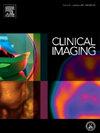The role of mammography in the detection and diagnosis of pregnancy-associated breast cancer
IF 1.5
4区 医学
Q3 RADIOLOGY, NUCLEAR MEDICINE & MEDICAL IMAGING
引用次数: 0
Abstract
Purpose
To evaluate the role of mammography in the diagnostic workup of pregnancy-associated breast cancer (PABC).
Materials and methods
This retrospective single-institution study included patients diagnosed with PABC from February 2009 to January 2024 and imaged by mammography. The additional diagnostic value of mammography as statistically compared with ultrasound (US) was evaluated, focusing on rate of initial detection, identification of additional cancer, changes in lesion size ≥1 cm, and changes in T-staging.
Results
A total of 167 patients with newly diagnosed PABC were included (mean age, 37.0 years ±4.4), including 30/167 (18 %) who were pregnant (mean pregnancy duration, 6.3 months ±2.7) and 137/167 (82 %) who were lactating. Almost all patient had dense breasts (163/167, 97.6 %), including 77 % with extremely dense breasts. Most PABCs (137/167, 82.0 %) were visible on mammography, including cases in which mammography was the sole detection modality (n = 21), had additional positive stereotactic biopsy (n = 17, 10.2 %), showed changes in lesion size by ≥1 cm (n = 35, 21.0 %) (P < 0.001), or changed the T-staging (n = 35, 21.0 %). Excluding cases with duplicate contributions, mammography added value in 64/167 (38.3 %) patients.
Conclusion
Despite the high proportions of increased mammographic density, mammography successfully demonstrated most pregnancy-associated breast cancers and frequently provided valuable additional information for their evaluation. Regardless of how PABC presents clinically, mammography and US must serve as complementary tools in the diagnostic evaluation of PABC.
乳房x光检查在妊娠相关乳腺癌的检测和诊断中的作用
目的探讨乳腺x线摄影在妊娠相关乳腺癌(PABC)诊断中的作用。材料和方法本回顾性单机构研究纳入了2009年2月至2024年1月诊断为PABC的患者,并进行了乳房x光检查。对乳腺x线摄影与超声(US)相比的附加诊断价值进行了统计学评价,重点是初始检出率、附加癌的识别、病变大小≥1cm的变化以及t分期的变化。结果167例新诊断PABC患者(平均年龄37.0±4.4岁),其中30/167例(18%)为妊娠期(平均妊娠时间6.3个月±2.7个月),137/167例(82%)为哺乳期。几乎所有患者均有致密性乳房(163/167,97.6%),其中极致密性乳房占77%。大多数PABCs(137/167, 82.0%)在乳房x光检查中可见,包括乳房x光检查是唯一检测方式的病例(n = 21),另外有立体定向活检阳性(n = 17, 10.2%),病变大小变化≥1 cm (n = 35, 21.0%) (P <;0.001),或改变t分期(n = 35, 21.0%)。排除重复贡献的病例,乳房x光检查在167例患者中有64例(38.3%)增加了价值。结论尽管乳房x线摄影密度增加的比例很高,但乳房x线摄影成功地显示了大多数妊娠相关乳腺癌,并经常为其评估提供有价值的附加信息。无论PABC的临床表现如何,乳房x光检查和超声检查都必须作为PABC诊断评估的补充工具。
本文章由计算机程序翻译,如有差异,请以英文原文为准。
求助全文
约1分钟内获得全文
求助全文
来源期刊

Clinical Imaging
医学-核医学
CiteScore
4.60
自引率
0.00%
发文量
265
审稿时长
35 days
期刊介绍:
The mission of Clinical Imaging is to publish, in a timely manner, the very best radiology research from the United States and around the world with special attention to the impact of medical imaging on patient care. The journal''s publications cover all imaging modalities, radiology issues related to patients, policy and practice improvements, and clinically-oriented imaging physics and informatics. The journal is a valuable resource for practicing radiologists, radiologists-in-training and other clinicians with an interest in imaging. Papers are carefully peer-reviewed and selected by our experienced subject editors who are leading experts spanning the range of imaging sub-specialties, which include:
-Body Imaging-
Breast Imaging-
Cardiothoracic Imaging-
Imaging Physics and Informatics-
Molecular Imaging and Nuclear Medicine-
Musculoskeletal and Emergency Imaging-
Neuroradiology-
Practice, Policy & Education-
Pediatric Imaging-
Vascular and Interventional Radiology
 求助内容:
求助内容: 应助结果提醒方式:
应助结果提醒方式:


